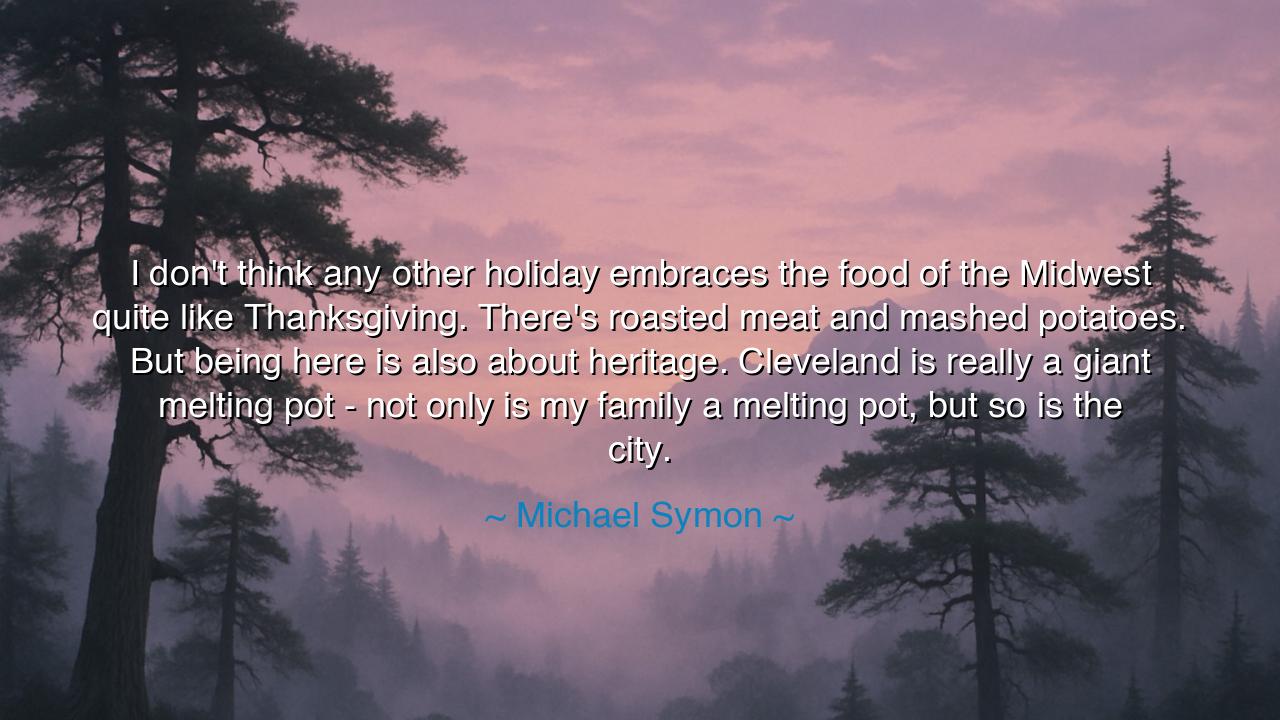
I don't think any other holiday embraces the food of the Midwest
I don't think any other holiday embraces the food of the Midwest quite like Thanksgiving. There's roasted meat and mashed potatoes. But being here is also about heritage. Cleveland is really a giant melting pot - not only is my family a melting pot, but so is the city.






Michael Symon, the son of Cleveland and a chef whose craft is steeped in the flavors of his homeland, once declared: “I don't think any other holiday embraces the food of the Midwest quite like Thanksgiving. There's roasted meat and mashed potatoes. But being here is also about heritage. Cleveland is really a giant melting pot - not only is my family a melting pot, but so is the city.” In these words lies the union of food, family, and heritage—the sacred trinity that makes Thanksgiving more than a meal, but a reflection of identity itself.
The Midwest, with its farms, hearths, and traditions, is a land where simplicity becomes richness. Roasted meat and mashed potatoes, humble in form, carry within them the memory of generations who worked the soil, tended animals, and gathered around tables after long days of labor. In these dishes, the bounty of the earth meets the comfort of tradition. They are not delicacies meant to impress strangers, but comfort foods that bind kin together in gratitude. When Symon speaks of these foods, he is not describing mere sustenance, but the taste of home, the flavor of belonging.
Yet Symon reminds us that Thanksgiving is more than food—it is heritage. For Cleveland, his city, is a place of immigrants, of peoples from many lands who brought their dishes, accents, and memories into one shared space. His own family, like so many others, is a tapestry of different cultures woven together. In such a city, Thanksgiving becomes more than an American holiday; it becomes the canvas upon which each family paints its own history. Pierogi may sit beside turkey, pasta beside stuffing, lamb beside pumpkin pie. The feast becomes a melting pot, not only of flavors, but of identities.
History testifies to this truth. When waves of immigrants came to America in the 19th and 20th centuries, many first encountered Thanksgiving as an unfamiliar holiday. Yet rather than rejecting it, they made it their own, adding their cultural dishes to the table. Italian families placed lasagna beside the turkey. Greek families brought lamb. Mexican families prepared tamales. And so Thanksgiving grew to represent not only America’s past, but its ever-changing present—a true celebration of the melting pot.
The deeper meaning of Symon’s reflection is that food is never only about the plate before us—it is a language of heritage. Each bite carries stories of ancestors, of villages left behind, of journeys across oceans, of new homes built in strange lands. To eat at a Thanksgiving table is to eat history itself, layered in flavors that tell us who we are and where we come from. The roasted meat speaks of farmers, the potatoes of earth turned by hand, the pies of grandmothers who baked with love.
The lesson for future generations is this: honor your heritage through food. When you sit down at the table, do not see only what is on the plate. See your ancestors standing behind you, whispering through the recipes they passed down. Teach your children not only to eat but to cook, for cooking is the act of remembrance. And welcome the dishes of others, for in sharing their flavors, you share their stories, and in doing so, you expand your own.
Practical wisdom follows from this. This Thanksgiving, ask your elders about the recipes they prepare. Write them down, learn their secrets, and pass them to your children. Invite friends of different backgrounds to your table, and let their dishes mingle with your own, so that the feast reflects not only your family, but the greater community. For food, when shared with gratitude, is the bridge that unites strangers into kin.
Thus, Michael Symon’s words ring with the wisdom of the ancients. Thanksgiving is not merely a feast of roasted meat and potatoes—it is a feast of heritage and identity, a reflection of both family and community. Let this teaching endure: that every dish is a story, every table a gathering of histories, and every Thanksgiving a chance to remember who we are, together, in the great melting pot of humanity.






AAdministratorAdministrator
Welcome, honored guests. Please leave a comment, we will respond soon